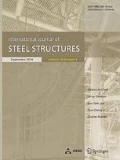Abstract
This study investigated the ultimate load capacity of assembled system supports by comparing cases with and without bracing members. Supports used as temporary structures are essential to resist the concrete casting load. Current trends encourage the use of system supports to prevent the collapse of supports, which occur frequently. Studies regarding the ultimate behavior of system supports in Korea are fewer than those in other countries. Existing studies have only focused on the behavior of unit members, such as vertical members. However, studies that focused on unit vertical members under axial loading reported difficulty in predicting the ultimate behavior of assembled system supports. Furthermore, the ultimate strength of the system support can be decreased significantly in cases without a bracing member, which occur frequently at actual sites. Therefore, the ultimate behavior of the system support considering actual construction site conditions was investigated through experimental tests, focusing on whether bracing members were installed. Experimental results showed that the load-carrying capacity of a three-story system support without a bracing member was 38.4% that of the system support with full bracing members. In addition, the load-carrying capacity of the three-story system support without bracing members decreased by 41.2% compared with that of a two-story system support without bracing members. This indicates that the installation of bracing members is essential for increasing the ultimate load capacity of system supports, and the number of stories of system supports should be considered to determine their ultimate strength.
















Similar content being viewed by others
References
Bong, J. K., Lee, H. D., Kim, S. J., Mha, H. S., Yin, D. K., & Won, J. H. (2019). Probabilistic characteristics of moment capacity and rotational stiffness of wedge joints used in support systems reflecting reused members. Applied Sciences, 9(19), 4056.
BSI. BS EN 1004. (2005). Mobile access and working towers made of prefabricated elements - Materials, dimensions, design loads, safety and performance requirements. London: British Standards Institution.
Chandrangsu, T., & Rasmussen, K. J. R. (2011). Investigation of geometric imperfections and joint stiffness of support scaffold systems. Journal of Constructional Steel Research, 67(4), 576–584.
Kang, J. O., Kang, Y. S., & Lee, M. S. (2005). Brief review on stability issues for slab system support. Journal of The Korea Institute for Structural Maintenance and Inspection, 9(2), 57–61. ((in Korean)).
Kim, H. S., Yeo, Y. K., Park, S. H., & Kim, Y. D. (2001). Investigation and analysis of construction situations affecting lateral displacement in form-shore system. Journal of Industrial Science Researches, 19(1), 135–142. ((in Korean)).
Kim, H. S., & Kim, G. M. (2002). Present condition analysis of system support during construction of rc building. Journal of Industrial Science Researches, 20(1), 115–122. ((in Korean)).
Kim, H. S. (2004). A study on collapse cause analysis of form-shore system according to design and construction defects. Journal of Industrial Science Researches, 21(2), 213–220. ((in Korean)).
Kwak, S. S., Kim, H. S., Jung, S. J., & Song, K. H. (2004). Experiment on load bearing capacity of prefabricated steel pipe scaffolding used as a shore. Journal of the Architectural Institute of Korea Structure & Construction, 20(9), 55–62. ((in Korean)).
Liu, B., Yi, M., Li, J., Chen, Z., Liu, Q., & Wen, L. (2018). Structural behavior of steel tube and coupler scaffolds with stability strengthening details. International Journal of Steel Structures, 18(1), 79–95.
Oh, B. H., & Choi, B. J. (2018). An analytical study on the change of system supports according to the brace installation. Journal of the Korean Society of Safety, 33(2), 104–111. ((in Korean)).
Park, M. S., Choi, B. J., Han, M. H., Lim, H. T., & Cho, T. G. (2017). A study on the improvements of assembling methods of system support for enhancing economic safety. Journal of Disaster and Safety, 1(1), 9–18. ((in Korean)).
Peng, J. L., Pan, A. D., Rosowsky, D. V., Chen, W. F., Yen, T., & Chan, S. L. (1996). High clearance scaffold systems during construction—I. Structural modelling and modes of failure. Engineering Structures, 18(3), 247–257.
Peng, J. L., Chan, S. L., & Wu, C. L. (2007). Effects of geometrical shape and incremental loads on scaffold systems. Journal of Constructional Steel Research, 63(4), 448–459.
Prabhakaran, U., Beale, R. G., & Godley, M. H. R. (2011). Analysis of scaffolds with connections containing looseness. Computers & Structures, 89(21–22), 1944–1955.
Won, J. H., Lee, H. D., Choi, M. K., & Park, M. C. (2018). Flexural strength and rotational stiffness estimation of joint between vertical and horizontal members in system support. Journal of the Korean Society of Safety, 33(4), 46–53. ((in Korean)).
Zhang, H., & Rasmussen, K. J. R. (2013). System-based design for steel scaffold structures using advanced analysis. Journal of Constructional Steel Research, 89, 1–8.
Acknowledgements
This research was supported by Occupational Safety and Health Research Institute. This research was also supported in part by a Grant (2016R1A2B4016327) from Basic Science Research Program funded by National Research Foundation of Korea(NRF).
Author information
Authors and Affiliations
Corresponding author
Additional information
Publisher's Note
Springer Nature remains neutral with regard to jurisdictional claims in published maps and institutional affiliations.
Rights and permissions
About this article
Cite this article
Do Lee, H., Won, JH., Jang, NG. et al. Experimental Study on Load Carrying Capacity Enhancement of System Supports Considering Full Installation of Bracing Members. Int J Steel Struct 20, 2051–2067 (2020). https://doi.org/10.1007/s13296-020-00430-5
Received:
Accepted:
Published:
Issue Date:
DOI: https://doi.org/10.1007/s13296-020-00430-5




